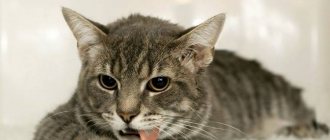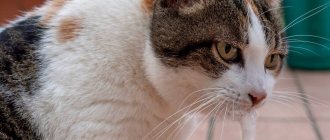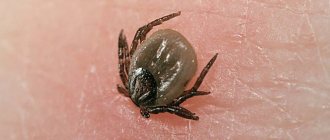Vomiting is a physiological process that develops if a cat has eaten something wrong and in a number of other cases. Cats are quite clean animals that constantly wash themselves and lick their coats; because of this, not only dirt, but also hair fibers get into the stomach. In addition, in some cases, animals eat grass and specifically stimulate the gag reflex, which helps cleanse the stomach. If the cat vomits white foam rarely, no more than 1-2 times a day, then there is nothing to worry about. But if your pet has uncontrollable vomiting, you need to urgently contact a veterinarian.
Causes of vomiting in cats
Vomiting in a cat can occur for various reasons. They can be designated as follows:
- The cat has overeated - large portions and eating too quickly quite often lead to regurgitation of excess food.
- Lumps of fur in the stomach, which form when licking the fur coat, lead to irritation of the mucous membrane and vomiting.
- Poisoning from low-quality food products.
- Cats eating indoor plants also often ends in vomiting.
- The entry of bones and foreign objects into the digestive tract leads to the release of the stomach contents.
- Gastritis is an inflammatory process of the gastric mucosa and is a common cause of nausea and vomiting in cats.
- Disruption of the pancreas leads to a deterioration in enzymatic processes during the digestion of food, and vomiting is possible.
- Volvulus or peritonitis - these pathologies are very dangerous for the animal’s life and require urgent intervention from a veterinarian.
- Diseases of the liver and gall bladder.
- Intoxication with medications or toxic substances.
- Infectious diseases - these conditions are accompanied by uncontrollable vomiting, lethargy and lack of appetite. In this case, treatment should be carried out by a doctor.
In addition, the cat may not eat anything and vomit if infected with worms. In this case, worms may be observed in the vomit, which indicates severe damage to the animal’s body.
To protect your pet from helminthic infestation, which negatively affects the entire body and significantly reduces immunity, it is necessary to give it anthelmintic once every 2-3 months. A veterinarian will help you choose the right medication.
First aid
If you notice that your cat is vomiting foam, but there are no other dangerous signs, you can do it yourself. It is especially important to know how to help your pet if it is not possible to quickly get to a veterinarian.
First of all, it is necessary to put the animal on a starvation diet. For 12-20 hours after the animal has vomited, you should not give the cat anything to eat. But water must be freely available. When the pet’s condition has stabilized, without repeated vomiting, you can try giving the cat some boiled rice.
The appearance of foam at the mouth of a cat should alert the owner, since there may be several reasons for this phenomenon. If you suspect intoxication of the body, it is necessary to give the animal an enterosorbent (Enterosgel, Atoxil, Activated carbon, Smecta) to quickly remove toxins. You can give antiemetic drugs such as Phenothiazine, Paspertine.
If it is not possible to travel or call a veterinarian at home, it is recommended to call the clinic and ask over the phone for the dosage of medications for your animal, indicating the weight and age of the pet, as well as the presence of accompanying symptoms.
If, after a starvation diet, a cat does not eat and vomits all day, then the cause of this phenomenon may be liver lipidosis and, in the absence of medical intervention, the animal is likely to die.
Why does a cat vomit white foam?
A cat vomiting white foam is normal, but only if there are no impurities in the foam, and it occurs infrequently. If a cat is vomiting white foam, then a malfunction of the biliary system can be suspected. When food is digested in the stomach and enters the intestines, mucus does not cease to be released, which, upon contact with air, takes the form of white bubbles. If there is too much mucus in the digestive organs, the body reflexively pours it out.
Cats are very sensitive to nutritional errors. If a cat has not eaten for a long time, it vomits white foam. This is explained by the fact that the digestive system produces all the secretions necessary for digesting food in the usual volume. But if food does not enter the stomach for a long time, then hydrochloric acid begins to corrode the walls of the organ, resulting in irritation and vomiting. For this reason, cats should not undergo therapeutic fasting for more than one day.
It turns out that cats can also have heartburn, in this case the cat vomits foam in the morning on an empty stomach, but no other health problems are observed.
Associated symptoms
The animal's symptomatic picture may be supplemented by discharge from the eyes.
If a castrated or regular cat vomits foam once, then there is no need to worry, since the problem is probably physiological. If the situation repeats itself over the course of a week or month and the pet continues to vomit foamy saliva, then it is recommended to see a veterinarian. In case of pathology, the clinical picture is supplemented by symptoms such as:
- nausea and vomiting of white foam;
- vomit with blood, in which mucous fibers are visible;
- decrease or increase in body temperature;
- discharge from the nose and/or eyes;
- persistent cough;
- weight loss and anorexia;
- depressed state;
- frequent diarrhea or constipation.
When a cat vomits a yellow liquid with foam, it usually does not eat anything and refuses to drink water, which can cause dehydration, which can lead to serious complications.
Vomiting foam in kittens
Kittens have a weak digestive system, so vomiting can occur quite often. The main reasons for this condition look like this:
- Sudden change in diet. For example, a kitten was separated from its mother and transferred to adult food, while its small stomach is not yet able to digest roughage.
- Harmful foods - fried, smoked, spicy or simply stale - can cause vomiting in the baby.
- Persistent overeating or large pieces of food - compassionate owners try to feed their pet more satisfyingly; it seems to them that the kitten is too thin. This will not lead to anything good.
- If the kitten licks itself often, then vomiting may be a consequence of the accumulation of hair in the ventricle. This is especially true for animals with long-haired breeds.
- Accidental entry of foreign objects into the stomach. While playing, the kitten may swallow a candy wrapper, a bead, or a piece of tinsel.
- Chemical poisoning – like all babies, kittens are very curious, so they may try dishwashing liquid or litter.
- Side effects after vaccination are how the body reacts to a foreign agent entering the body.
- Congenital diseases of the liver or pancreas.
If the baby vomits, it is necessary to find out the cause of this phenomenon and eliminate it. If this condition is rarely observed, then you can observe the kitten and try to adjust the diet. When liquid, foamy vomiting is observed frequently, you need to go to a veterinary hospital.
A healthy kitten should be active and have a good appetite. If the baby is lethargic, refuses to play and eats poorly, then this is a reason to visit the doctor.
Examination of cats
To identify the cause of frequent vomiting, the veterinarian interviews the cat's owner and carefully examines the animal. If necessary, a number of studies are carried out. This approach allows you to quickly find the cause of the illness and begin to treat your sick pet. The inspection is usually carried out in several successive stages and consists of the following points:
- Interview the owner to obtain information about the frequency and duration of vomiting.
- Clarification of the cat’s diet, as well as the possibility of foreign objects entering the digestive tract.
- Determining the type and thickness of vomit, finding out information when the animal began to vomit.
- Examination of the animal, determination of general condition and reflexes.
- Clarification of information about chronic cat diseases.
If the cat has only once vomited clear liquid with a small admixture of hair, then it is worth observing the pet throughout the day. Most often, this condition stabilizes very quickly, and after a few hours the cat is playful and active. However, when vomiting becomes indomitable and the animal becomes lethargic and apathetic, dehydration sets in very quickly, which causes irreversible processes in the body. You can’t hesitate here; only a doctor can provide help. In severe cases, surgery and intravenous fluids may be needed.
The owner should be wary if the animal does not allow its belly to be touched or to be picked up. This may indicate an inflammatory process in the abdominal area.
Varieties of vomit
Very often, the cause of the illness can be determined by the color and consistency of the vomit:
- When an animal vomits a yellow foamy mass, this means that during the digestion of food a certain amount of bile enters the stomach. This is a common occurrence with gastritis, colitis and diseases of the biliary tract. Due to the release of excess bile, the liver is partially cleansed of toxins and pathogenic microorganisms. Yellowish vomiting can occur with calcivirosis, a sudden change in diet, or when a foreign body enters the stomach.
- Vomiting of clear liquid or saliva may occur with distemper. The cat may also have yellow foam, which does not contain food debris or hair fibers. With each attack of vomiting, the animal becomes worse and worse, it begins to hide from people and light. The emanating colorless liquid indicates that dehydration has begun. This condition can quickly lead to death.
- When a cat vomits right after eating, this may indicate parasites, which are often found even in pets, hair accumulated in the stomach, or poor nutrition, when the portions are too large and the food is fatty.
- Regurgitation of worms indicates a severe infection of the animal with parasites. In this case, the cat’s contact with people is limited and a course of anthelmintic treatment is carried out. The drug should be selected by a doctor based on the results of a stool analysis.
A cat who does not eat at all for more than two days and periodically vomits may be seriously ill. In this case, you need to undergo a series of tests, as well as undergo an ultrasound of the internal organs. Such vomiting is not considered physiological and indicates illness.
Vomiting blood may be the result of an insect or reptile bite. In this case, the sick animal is urgently taken to any medical facility.
Carrying out prevention
Prevention of sudden attacks of the gag reflex is carried out with the help of:
- regular anti-worm therapy. For cats walking outside every 3 months;
- annual vaccinations, preventive examinations at a veterinary clinic for timely detection of hidden diseases;
- proper nutrition. Balanced ready-made food in sufficient quantities will help avoid pathological conditions;
- pet care. Brushing will prevent the accumulation of hairballs in the stomach;
- maintaining hygiene in the home. A clean room and no small objects that the cat could swallow.
Combing
White foam along with the contents of the stomach can have both physiological and pathological origin. The appearance of accompanying clinical signs requires seeking professional help and undergoing a full diagnostic examination. Timely treatment will avoid complications and save the life of your pet.
How to help a cat when vomiting
You can help your cat on your own, but only if there is no high fever, diarrhea or general weakness. When such a malaise indicates poisoning, the algorithm of actions should be as follows:
- The animal is stopped feeding and provided with a sufficient amount of drink. Only water can be given; dairy products are not recommended during this period.
- The cat is given a weak solution of potassium permanganate; it can be added to drinking water or poured into the mouth from a syringe with a soft tip.
Manganese is first diluted in a small volume of water, and then added to the drink, and poured through several layers of gauze to prevent undissolved crystals from entering the stomach.
- Every two hours, the pet is given smecta dissolved in a small volume of water.
Therapeutic fasting for cats should last about 12 hours. After this, you can gradually return the cat to its normal diet. First, they adhere to a gentle diet and give boiled chicken meat, as well as strong rice water, then chicken broth or special medicinal food is introduced. After 3-4 days, the cat is transferred to standard food. Usually such actions are enough for the pet to recover and return to a full life.
Causes of food poisoning
Poisoning can be due to various reasons. There are toxic infections and toxic poisonings.
Foodborne toxic infection occurs as a result of pathogenic microorganisms entering the gastrointestinal tract (GIT) with food. As a rule, the causative agent is pathogenic bacteria that multiply in products if they are improperly stored or get into ready-made food if it is not properly processed.
Toxic poisoning can be caused by various poisons - chemicals or natural toxins found in poisonous berries, mushrooms and many other foods.
The greatest danger from the point of view of food poisoning is represented by perishable foods: fish, meat, milk, salads, etc. Also, eggs, home-canned food, fruits and vegetables with a high content of nitrates, poisonous mushrooms and berries, raw beans, sprouted green potatoes and insufficiently washed raw vegetables and fruits can lead to food poisoning.
It is not recommended to consume products that have expired, are in swollen jars, are in damaged original packaging, or have an unusual appearance, smell, consistency and color.
When you need to see a doctor urgently
There are a number of cases when the owner does not know what to do and how to help the fluffy. First of all, you need to stop panicking, because panicking will not help the matter, and seek help from specialists. A trip to the hospital should be immediate in the following cases:
- The cat has been vomiting water or foam for more than 3 hours.
- The vomit is white or yellowish in color, but there are bloody spots in it.
- The pet refuses not only food, but also drink, and continuously vomits.
- In addition to the main symptom, diarrhea began, the animal’s nose became dry and hot, which indicates an elevated temperature. In addition, the owner should be alert to convulsions, which indicate dehydration and damage to the central nervous system.
In all these cases, you should not self-medicate, so as not to further aggravate the situation. It is better to entrust the health and life of your pet to a qualified doctor who will correctly diagnose and prescribe adequate treatment.
In some cases, cats are prescribed antibiotics to treat infectious diseases. Properly selected medications can quickly get your family pet back on his feet.
How to protect a cat from poisoning
Any disease is easier to prevent than to treat, so attention should be paid to the prevention of diseases and poisoning. To protect your cat from poisoning and digestive disorders, you should adhere to the following rules:
- Give the animal only healthy and fresh food. If you use dry food for feeding, then you should not skimp on it; you need to choose high-quality products.
- Do not overfeed fluffies and especially kittens; portions should be appropriate for age and weight.
- Food should be lukewarm and finely chopped.
- Periodically, cats are given anthelmintic drugs.
- All vaccinations are given according to schedule.
If trouble happens and your beloved cat gets sick, you need to act quickly. In most cases, the health of the animal and its life depend on the coordinated actions of the owner. When your pet's condition worsens by the minute, you need to quickly go to the hospital.











